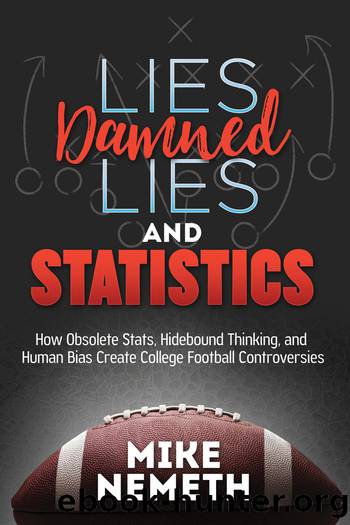Lies, Damned Lies and Statistics by Nemeth Mike;

Author:Nemeth, Mike; [Mike Nemeth]
Language: eng
Format: epub
Publisher: Morgan James Publishing
Published: 2018-08-15T00:00:00+00:00
Chapter Six
Geek Numbers
What these geek numbers showâno
proveâis that the traditional yardsticks
of success for players and teams are
fatally flawed.
âFrom the jacket cover of
Moneyball by Michael Lewis
Now that we understand how teams score and prevent points, which is to say, how teams win football games, we can invent metrics to represent the deterministic factors to be combined in an algorithm to grade a teamâs performance in a specific game. The factors I invented are listed below:
1.Long Field Efficiencyâthe percentage of long field possessions on which a team kicks a field goal or scores a touchdown. This statistic is collected for offense and defense. On average, the 21 sample teams scored on 39.83 percent of their long field possessions while their opponents scored on 22.38 percent. Oklahoma (56.20), UCF (52.34), and Oklahoma State (51.72) led this category playing against subpar defenses while Ohio State (49.33) and Alabama (49.12) were close behind against better defenses. On the other side of the ball, Clemson surrendered scores on only 15.38 percent of its opponentsâ possessions. Alabama (16.15) and Wisconsin (17.04) were next best. USC was worst in this category at 32.9 percent. Oklahoma State (32.5), Stanford (32.1) and Oklahoma (31.9) were nearly as bad.
2.Long Field Proficiencyâthe number of points scored on long field possessions divided by the number of long field possessions. This statistic, which rewards a team for scoring touchdowns and not settling for field goals, is a modifier for Long Field Efficiency and is collected for both offense and defense. Sample teams averaged 2.48 points per long field possession while holding their collective opponents to 1.33 points. Oklahoma (3.64), UCF (3.34), and Oklahoma State (3.18) were best against weak defenses while Alabama (3.05) and Ohio State (3.04) were quite good against better defenses and the only other teams to average more than 3 points for every long field possession. On the defensive side of the ball, Alabama and Wisconsin gave up just 0.87 points per opponent long field possession and Clemson and Georgia were next best at 0.89 points. Stanford (1.94), Oklahoma (1.93), Oklahoma State (1.93), and USC (1.90) were easiest to score upon.
3.Explosive Playsâthe number of plays covering at least twenty-five yards, including plays by the defense and special teams. The statistics is collected for offense and defense. As you might expect, UCF (73), Oklahoma State (69) and Oklahoma (67) were the most explosive teams during the 2017 season. Washington (13) and Alabama (22) surrendered the fewest explosive plays.
4.Average Field Positionâthe sum of all starting yard lines divided by the number of possessions, collected for offense and defense.
5.Drive stoppers. Collected only for the offense, this statistic records the percentage of long field possessions that are brought to a halt after an initial first down, by a turnover, a sack or a major penalty. UCF (12.5 percent) and Georgia (12.69) shot themselves in the foot least often. Wisconsin (25.95) and LSU (23.97) stopped themselves most often.
6.Third Down Avoidance Percentage. Third down plays divided by plays on first down. Measures a teamâs ability to achieve another first down with a first or second down play.
Download
This site does not store any files on its server. We only index and link to content provided by other sites. Please contact the content providers to delete copyright contents if any and email us, we'll remove relevant links or contents immediately.
| Baseball | Basketball |
| Children's Sports | Football (American) |
| Golf | Hockey |
| Soccer | Tennis |
| Training & Conditioning |
The Inner Game of Tennis by W. Timothy Gallwey(3513)
The Chimp Paradox by Peters Dr Steve(2250)
Advanced Strength and Conditioning by Anthony Turner & Paul Comfort(2142)
The Quarterback Whisperer by Bruce Arians(2072)
The Sports Gene: Inside the Science of Extraordinary Athletic Performance by David Epstein(2070)
Pep Confidential by Martí Perarnau(1694)
ALEX FERGUSON My Autobiography by Alex Ferguson(1449)
The Golden Rules: 10 Steps to World-Class Excellence in Your Life and Work by Bob Bowman & Charles Butler(1397)
The Score Takes Care of Itself by Bill Walsh(1392)
Golf is Not a Game of Perfect by Bob Rotella(1327)
When Pride Still Mattered by Maraniss David(1312)
Total Hockey Training by Sean Skahan(1293)
The Captain Class by Sam Walker(1254)
Soccer Men: Profiles of the Rogues, Geniuses, and Neurotics Who Dominate the World's Most Popular Sport by Simon Kuper(1219)
The Art of Innovation by Tom Kelley(1210)
Coach Wooden and Me by Kareem Abdul-Jabbar(1117)
Le camp by Unknown(1097)
Paterno by Joe Posnanski(1081)
The Blueprint by Jason Lloyd(1066)
